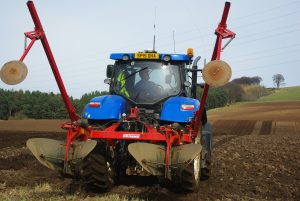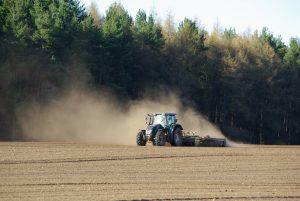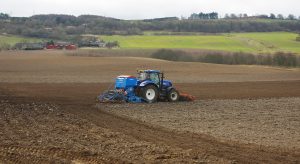The week began with gale force winds, freezing conditions and snow, and ended up in almost summer like conditions – a typical Scottish spring week really. The maximum temperature recorded on Tuesday was 4.8C, with a ‘feels like’ temperature of -3.5C. Saturday brought a maximum of 16.8C, although a cool breeze meant it only felt like 14.8C. Although there wasn’t a lot of rain during the week it was enough to stop us, and then the wind was so cold the ground dried out very slowly.
Amazingly drilling continued at the start of the week until we were snowed off on Tuesday afternoon. Euan had managed to dodge the showers, and drilled just under 100 acres (40 hectares) in a little over 3 days. We haven’t done any since then due to things having to dry out, and the contractor being busy elsewhere. With a good forecast

for this week, we aren’t too bothered, as when he does come, most fields will be ready.
There was some activity though. We rent out some ground for carrots to Edenwood Farm, and they made a start to prepare the ground. Fertiliser was spread, and then the deep ridger appeared, complete with GPS system.

When the weather did improve at the weekend we were able to get on and roll the fields of spring barley that had been sown. Rolling serves a double purpose, firstly firming up the seedbed, and also pushing down any stones that may be near the surface. Rolling is also a fine job to learn how to drive to a mark, and to be able to judge turning widths etc. Cameron was given the job as his first tractor work, and was getting on fine once he got the hang of it.

The final story of the week was the purchase of a new cultivator. We’ve been needing one for a while, but not really found what we were looking for. We got this one on demonstration from McLaren Tractors, and so far it has done all that we have asked of it, so it is here to stay.



